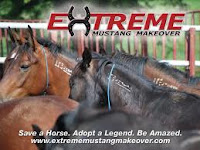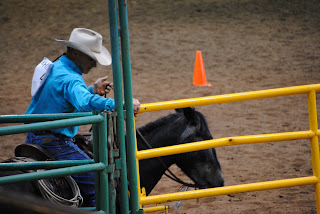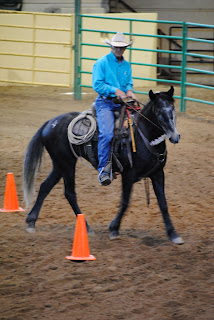Week 44: Mustang Makeover
 Like many little girls growing up in Colorado, I loved horses. When I was six or seven, my parents acquired a real live horse for my sister and me, and that’s when I realized that my love was more…theoretical in nature. Dusty was a gentle, patient creature, but everything about him, from his crushing hooves to his massive head and chomping teeth, seemed designed for the sole purpose of causing me bodily harm. As if my constant anxiety in his presence wasn’t enough, the year-round schlepping of hay and water was quite a lot of hard work. Needless to say, my career as a budding horsewoman didn’t last long.
Like many little girls growing up in Colorado, I loved horses. When I was six or seven, my parents acquired a real live horse for my sister and me, and that’s when I realized that my love was more…theoretical in nature. Dusty was a gentle, patient creature, but everything about him, from his crushing hooves to his massive head and chomping teeth, seemed designed for the sole purpose of causing me bodily harm. As if my constant anxiety in his presence wasn’t enough, the year-round schlepping of hay and water was quite a lot of hard work. Needless to say, my career as a budding horsewoman didn’t last long. Despite all that (much of which I’ve thankfully outgrown) I have a deep appreciation for horses and their role in shaping the American West. And the iconic wild mustang is not a thing of the past. According to the U.S. Bureau of Land Management, more than 38,000 wild horses and burros roam on BLM-managed land in 10 western states. Colorado has four herd-management areas: Little Bookcliffs, Spring Creek, Sandwash, and Piceance/E. Douglas, all in the far western part of the state.
Despite all that (much of which I’ve thankfully outgrown) I have a deep appreciation for horses and their role in shaping the American West. And the iconic wild mustang is not a thing of the past. According to the U.S. Bureau of Land Management, more than 38,000 wild horses and burros roam on BLM-managed land in 10 western states. Colorado has four herd-management areas: Little Bookcliffs, Spring Creek, Sandwash, and Piceance/E. Douglas, all in the far western part of the state.A herd of wild horses can double in size every four years, so the BLM must remove thousands of animals each year to prevent overcrowding. The Wild Free-Roaming Horses and Burros Act of 1971 insures that this is done humanely. Ideally, these horses will eventually find homes through programs such as the Extreme Mustang Makeover. This national challenge, which visited Fort Collins last weekend, gives trainers just 90 days to take a mustang from wild to mild.
Throughout the process, trainers must abide by the program’s regulations for care, boarding, and transportation of the mustang. If all goes well, the horse and trainer are then able to participate in the EMM to “showcase the talent and trainability of Mustangs.” (If you’re thinking of giving it a go someday, keep in mind that “Silver on your saddles or sequins on your shirts will not earn you any extra points.” Dang.)


I sat in on the Handling and Conditioning part of the competition, which required the trainers to lead and ride their mounts through a series of basic obstacles and maneuvers. Had I not known, I never would have guessed that the trainers and horses had been working together for a mere three months. But what was obvious to me was how much the trainers care for and respect their equine partners. And though I’ve already established that I’m no horse expert, I’m pretty sure the respect was mutual.
I was not able to return on Sunday to see how many of the mustangs found new homes as a result of their extreme makeovers, but I hope it was the majority of them. They’re fine animals and deserve the opportunity to prove it.

Bruce Spencer and Wyatt show their stuff

Comments